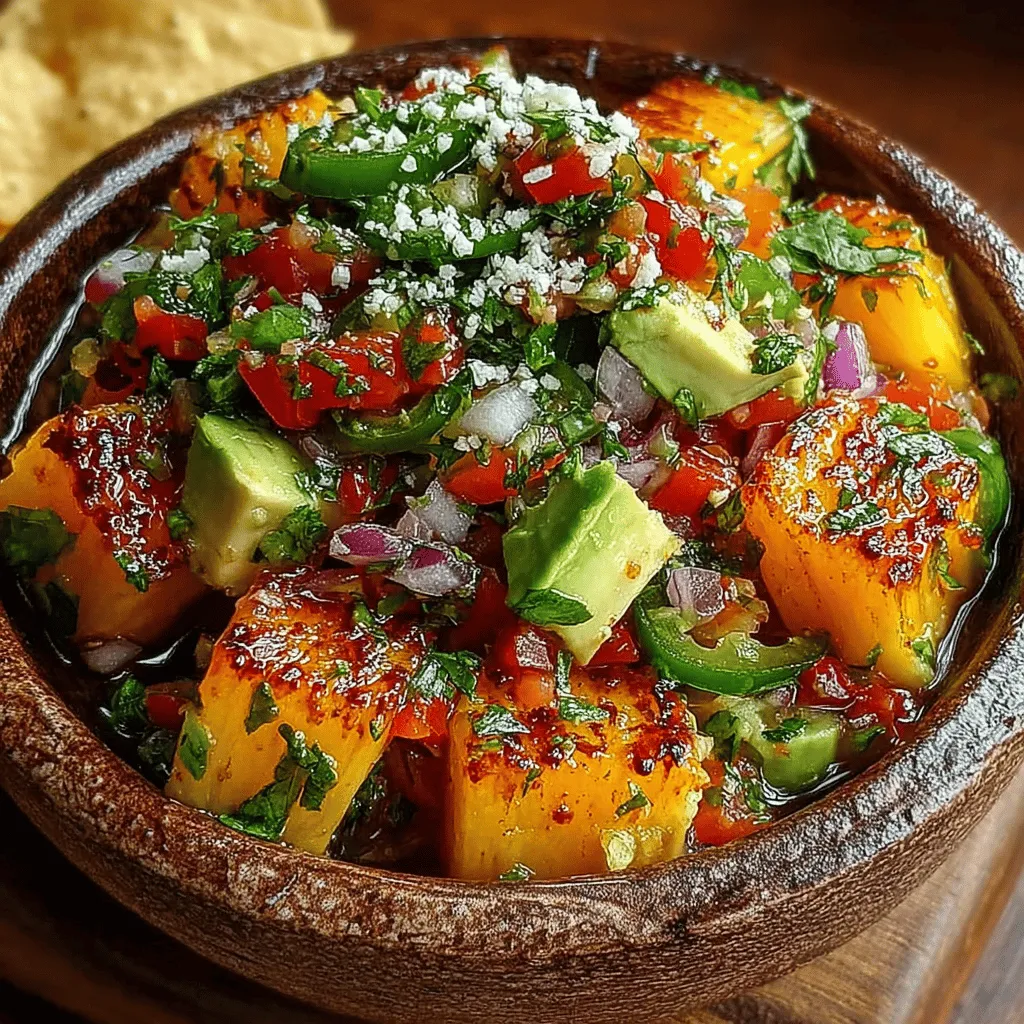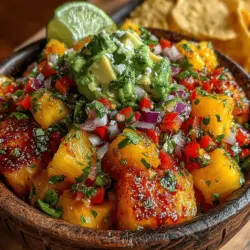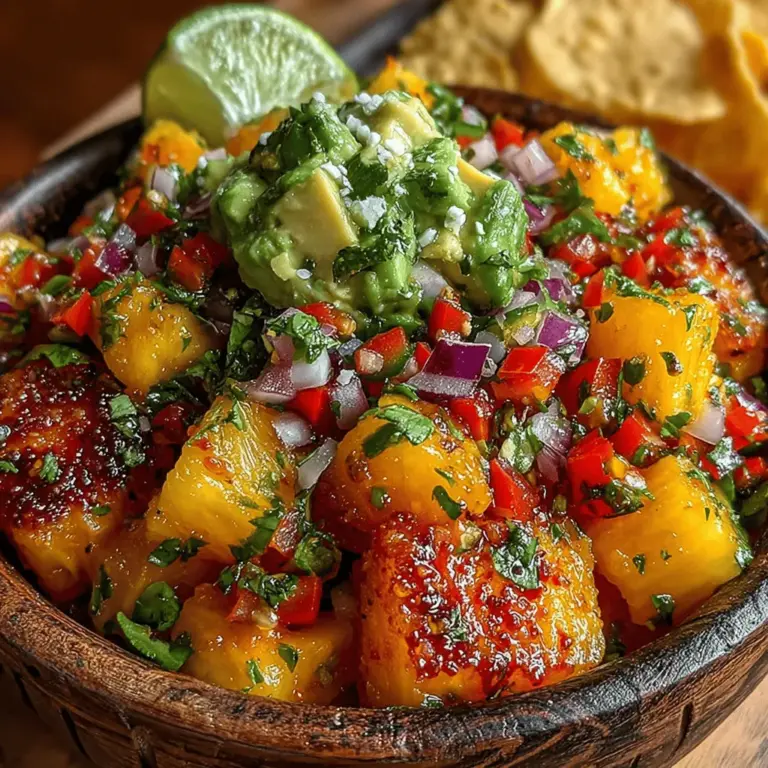Introduction to Tropical Fiesta Pineapple Mango Salsa
As the summer sun begins to shine, the allure of fresh, vibrant flavors becomes irresistible. Enter Tropical Fiesta Pineapple Mango Salsa — a delightful concoction that embodies the essence of summer with every bite. This refreshing salsa is a celebration of tropical fruits, combining the sweetness of ripe pineapple and mango with the crunch of colorful vegetables for a zesty topping or a perfect companion to your favorite grilled dishes. Whether served at a backyard barbecue, a family gathering, or simply enjoyed on a quiet evening, this salsa brings a burst of flavor that is both exciting and satisfying.
The secret to crafting the perfect Tropical Fiesta Pineapple Mango Salsa lies in the quality of the ingredients. Fresh fruits and herbs not only enhance the salsa’s flavor profile but also elevate its visual appeal. When you choose ripe, seasonal produce, you’re guaranteed a vibrant dish that tantalizes the palate and pleases the eyes. Fresh ingredients are paramount in creating a salsa that stands out; they provide the essential sweetness, acidity, and crunch that make this dish a crowd-pleaser.
In this article, readers can expect to dive deep into the world of Tropical Fiesta Pineapple Mango Salsa. We will explore the key ingredients that make this dish shine, highlighting their nutritional benefits and tips for selecting the best produce. Following that, we will guide you through the step-by-step preparation process, ensuring that you feel confident and inspired to create this tropical delight in your own kitchen.
Understanding the Ingredients
Pineapple: The Star Ingredient
At the heart of this salsa is the pineapple, a fruit that exudes tropical vibes and sweetness. Known for its juicy texture and tangy flavor, pineapple is not just a delicious addition to any dish but also packs a nutritional punch. This tropical fruit is rich in vitamins C and B6, manganese, and dietary fiber, contributing to overall health and wellness. Pineapple is celebrated for its digestive benefits, particularly due to the enzyme bromelain, which can aid in breaking down proteins and reducing inflammation.
Selecting a ripe pineapple is crucial to achieving the optimal sweetness for your salsa. When shopping for a pineapple, look for one that has a sweet aroma at the base, indicating ripeness. The skin should be golden-yellow, and the leaves at the crown should be green and fresh. A slight squeeze should yield a little give, suggesting that the fruit is juicy and ready to be enjoyed.
Mango: A Tropical Delight
Complementing the pineapple is mango, another tropical superstar known for its luscious sweetness and smooth texture. Rich in vitamins A and C, fiber, and antioxidants, mangoes provide numerous health benefits, including improved digestion and enhanced skin health. The juicy flesh of a ripe mango adds depth to the salsa while balancing the acidity of the pineapple.
When choosing a mango, look for one that yields slightly to pressure, indicating ripeness. The skin color can vary depending on the variety, but generally, a mango should have a vibrant hue with some yellow or red tones. Avoid mangoes that are overly soft or have dark spots, as these may indicate overripeness.
Colorful Additions: Bell Pepper and Onion
To enhance the texture and color of your Tropical Fiesta Pineapple Mango Salsa, red bell pepper and red onion are essential additions. Red bell peppers are not only visually appealing but also boast a range of nutritional advantages. They are high in vitamins A and C, potassium, and antioxidants, making them a healthy choice that contributes to various health benefits, including improved vision and a stronger immune system.
Red onion, though often overlooked, plays a critical role in enhancing the flavor profile of the salsa. Its sharpness adds depth and complexity, while its vibrant color makes the dish even more enticing. Additionally, red onions contain quercetin, a powerful antioxidant that can help reduce inflammation and promote heart health.
Building Heat: The Jalapeño
For those who enjoy a little kick, jalapeño peppers are the perfect way to introduce heat into your salsa. These peppers vary in heat levels, which can be adjusted based on your personal preference. Jalapeños range from mild to medium heat on the Scoville scale, with the seeds and membranes containing the most heat. If you prefer a milder salsa, consider removing the seeds and inner membranes before dicing the pepper. Conversely, for those who enjoy a spicier kick, feel free to include them.
Incorporating jalapeños not only adds heat but also brings additional flavor complexity to the salsa. The spiciness complements the sweetness of the pineapple and mango, creating a harmonious balance that tantalizes the taste buds.
Freshness Factor: Cilantro and Lime
No salsa is complete without the bright, fresh notes of cilantro and the zesty acidity of lime. Fresh herbs like cilantro elevate the flavor profile of the Tropical Fiesta Pineapple Mango Salsa, adding a burst of freshness that cuts through the sweetness of the fruits. Cilantro is also packed with vitamins A, C, and K, as well as essential oils that can promote digestive health.
Lime juice is essential in balancing the flavors of the salsa, providing acidity that enhances the overall taste. The tartness of lime juice helps to brighten the dish, ensuring that the sweetness of the pineapple and mango does not overwhelm the palate. When selecting limes, look for ones that feel heavy for their size and have smooth, glossy skin.
Optional Creaminess: Adding Avocado
For those looking to add a touch of creaminess to their Tropical Fiesta Pineapple Mango Salsa, avocado is an excellent optional ingredient. This nutrient-dense fruit is high in healthy fats, vitamins E, K, and B6, and folate, making it a nutritious addition to any dish. Avocado not only enhances the texture of the salsa but also adds a rich, creamy element that complements the tropical flavors beautifully.
When selecting an avocado, opt for one that yields slightly to gentle pressure, indicating ripeness. Avoid avocados that are overly soft or have dark spots, as these may signify overripeness. Adding diced avocado to your salsa will create a delightful contrast to the other ingredients, enriching the overall experience of this tropical treat.
Step-by-Step Preparation of Tropical Fiesta Salsa
Now that you have a thorough understanding of the ingredients that will come together to create the Tropical Fiesta Pineapple Mango Salsa, it’s time to roll up your sleeves and start preparing this vibrant dish. The preparation process is straightforward and allows for customization based on your preferences.
1. Preparing the Ingredients: Begin by gathering all your fresh ingredients. Start by cutting the pineapple; remove the outer skin, core, and dice the flesh into small chunks. Next, peel the mango, remove the pit, and cut the flesh into similar-sized pieces as the pineapple.
2. Chop the Vegetables: Dice the red bell pepper and red onion, ensuring the pieces are uniform in size for even distribution within the salsa. For the jalapeño, remember to adjust the heat level to your liking by removing the seeds if desired. Finely chop the jalapeño and add it to the mix.
3. Herbs and Lime Juice: Finely chop the fresh cilantro and set it aside. Then, squeeze the juice from a fresh lime, ensuring you capture all the tangy goodness that will elevate the flavors of the salsa.
4. Combine and Mix: In a large mixing bowl, combine all the diced fruits, vegetables, cilantro, and lime juice. Gently toss the mixture together, careful not to mash the ingredients. Taste and adjust the seasoning as needed — you may want to add a pinch of salt or more lime juice, depending on your preference.
With the preparation steps complete, you are now ready to serve your Tropical Fiesta Pineapple Mango Salsa. This dish is perfect for pairing with tortilla chips, topping grilled fish or chicken, or adding a refreshing twist to tacos. Stay tuned for the next part of this article, where we will delve into serving suggestions and more creative ways to enjoy this tropical delight.

Detailed Methods for Peeling, Coring, and Dicing Pineapple and Mango
To create the perfect Tropical Fiesta Pineapple Mango Salsa, mastering the art of peeling, coring, and dicing the pineapple and mango is essential. Below are step-by-step methods to help you prepare these tropical fruits with ease.
Peeling and Dicing Pineapple
1. Peeling the Pineapple: Start by placing the pineapple upright on a cutting board. Using a sharp chef’s knife, carefully slice off the top crown and the base of the pineapple to create a stable foundation. Then, begin at the top and slice downward, following the curve of the fruit to remove the skin. Make sure to cut deep enough to eliminate the “eyes” (the brown spots) but not so deep that you waste the flesh.
2. Coring the Pineapple: After peeling, cut the pineapple into quarters vertically. Use a paring knife to carefully cut out the core from each quarter, which is tougher and not suitable for the salsa.
3. Dicing the Pineapple: Lay the pineapple quarters flat on the board and slice them into strips, then turn them to dice into small, even cubes. Aim for about half-inch pieces to ensure they mix well with the other ingredients.
Peeling and Dicing Mango
1. Peeling the Mango: Hold the mango upright. Use a vegetable peeler or a sharp knife to remove the skin, taking care to preserve as much of the flesh as possible.
2. Cutting the Mango: Identify the pit in the center of the mango. To remove the flesh, slice off the two large cheeks on either side of the pit. Then, make horizontal and vertical cuts in the flesh without cutting through the skin, and scoop the diced fruit out with a spoon.
3. Dicing the Mango: Cut the cheeks into small cubes similar in size to the pineapple. Consistency in size will help the flavors meld beautifully in the salsa.
Cutting Techniques for Bell Peppers, Onions, and Jalapeños
Once you have prepared the fruits, it’s time to tackle the vegetables. Proper cutting techniques will ensure an even mix and enhance the overall texture of your salsa.
Bell Peppers
1. Slicing the Bell Peppers: Start by removing the top and bottom of the bell pepper. Cut it in half from top to bottom and remove the seeds and membranes. Lay half flat on the cutting board, and slice into thin strips. Rotate the strips and chop them into small, uniform pieces.
Onions
1. Chopping the Onions: Cut off the stem and root ends of the onion, then slice it in half from top to bottom. Peel the outer layer and lay it flat on the board. Make vertical cuts towards the root, then slice across horizontally to create finely diced pieces.
Jalapeños
1. Preparing the Jalapeños: Wearing gloves, slice the jalapeño in half lengthwise. Remove the seeds and membranes for less heat, or leave them in for a spicier salsa. Cut the halves into thin strips and then dice them into small pieces.
Mixing Process
Gentle Mixing to Maintain Integrity
Using a large mixing bowl, start adding your diced pineapple, mango, bell peppers, onions, and jalapeños. It’s crucial to mix gently with a spatula or wooden spoon to preserve the texture of the fruits. Over-mixing can break down the fruit and create a mushy salsa.
Ensuring Even Distribution of Flavors
As you mix, take care to ensure that the ingredients are evenly distributed throughout the bowl. This will help each bite of salsa pack a punch of flavor. Consider layering the ingredients as you add them, mixing in bursts, rather than all at once, to promote an even blend.
Flavor Development
The Significance of Resting Time
Once your salsa is mixed, it’s beneficial to let it rest for at least 30 minutes before serving. This resting time allows the flavors to meld together, enhancing the overall taste. The natural sugars from the pineapple and mango will infuse into the onions and jalapeños, creating a delightful balance.
Importance of Seasoning to Personal Taste
Taste your salsa after the resting period and adjust the seasoning as necessary. A pinch of salt and a squeeze of lime can elevate the flavors even further. Everyone has different taste preferences, so feel free to add more lime juice or even a dash of hot sauce for an extra kick.
Serving Suggestions for Your Tropical Salsa
Pairing with Tortilla Chips
When it comes to serving your Tropical Fiesta Pineapple Mango Salsa, it’s hard to beat the classic combination with tortilla chips. Opt for thicker, sturdy chips that can hold up to the juicy salsa without breaking. Flavorful options like lime or chili tortilla chips can also add an extra dimension to your snacking experience.
As a Topping for Grilled Proteins
This salsa is not just a dip; it can also serve as a vibrant topping for grilled proteins. Grilled fish such as mahi-mahi, salmon, or even shrimp pairs beautifully with the sweetness of the salsa. Chicken, especially when marinated with citrus flavors, also complements it well, enhancing your meal with tropical flair.
Versatile Uses in Tacos and Bowls
Elevate your taco night by using this salsa as a topping for fish or chicken tacos. It adds a refreshing contrast to savory meats and creamy toppings like avocado or sour cream. Additionally, consider using the salsa in grain bowls with quinoa, black beans, and grilled vegetables for a healthy, satisfying meal.
Incorporating into Summer Dishes
This salsa shines in summer dishes. Use it as a topping for grilled pizzas, or mix it into a refreshing summer salad with leafy greens and feta cheese. It can also be spooned over avocado toast for a tropical breakfast twist, making it a versatile summertime staple.
Health Benefits of Tropical Ingredients
Nutritional Analysis
The Tropical Fiesta Pineapple Mango Salsa is not just a delicious addition to your meals; it’s also packed with nutritional benefits. Pineapples are rich in vitamin C and bromelain, an enzyme known for its anti-inflammatory properties. Mangos provide a good source of vitamin A, fiber, and antioxidants, which contribute to overall health.
Bell peppers add another layer of nutrition, being high in vitamins A and C while also providing dietary fiber. Onions offer heart-healthy compounds and can help boost your immune system. Jalapeños, aside from their heat, are low in calories and high in vitamins, making them a great addition.
Low-Calorie Snack Option
This salsa is a guilt-free addition to your meal repertoire. With its low-calorie content, it makes for an excellent snack option that can be enjoyed on its own or paired with healthy choices like whole-grain crackers or fresh vegetable sticks. It’s a great way to satisfy cravings while maintaining a balanced diet.
Conclusion: Embracing the Tropical Fiesta in Every Bite
The Tropical Fiesta Pineapple Mango Salsa is a celebration of vibrant flavors and fresh ingredients that can transform any meal. Its versatility and ease of preparation make it a go-to recipe for summer gatherings, barbecues, or a simple weeknight dinner.
Don’t hesitate to experiment with the recipe, adding your unique twist or adjusting the levels of sweetness and spice to suit your taste. Enjoy the culinary journey through tropical flavors, and let every bite take you to an island paradise. Embrace the freshness and creativity that this salsa brings to your table and share it with friends and family for an unforgettable dining experience.


